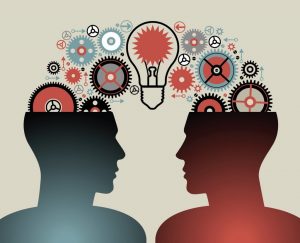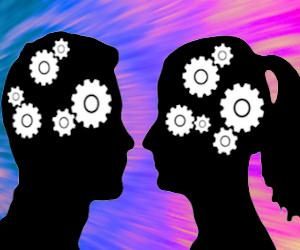It addresses the brain in the way it actually develops, matures and operates.
Neuroscience surprisingly teaches us that not only is psychotherapy purely biological, but the only real biological treatment. It addresses the brain in the way it actually develops, matures and operates. It follows the principles of evolutionary adaptation. It is consonant with genetics. And it specifically heals the problematic adaptations of the brain in precisely the ways they evolved in the first place.
Psychotherapy deactivates maladaptive brain mappings and fosters new and constructive pathways.
The operations of the brain are purely biological. The brain maps our experience through the linking of trillions of webs of neuron (memory-glued) circuits. These interconnected webs of webs of webs create larger circuits that map all throughout the architecture of the cortex. This generates high level symbolic neuronal maps that take form as images in our consciousness. The play of consciousness is the highest level of symbolic form. It is a living theater of image-ination, a representational world that consists of a cast of characters who relate together by feeling, as a well as scenarios, plots, set designs, and landscapes.
As we adapt to our environment, the brain maps our emotional experience through cortical memory. This starts very early in life. If a baby is startled by a loud noise, his arms and legs will flail. His heart pumps adrenaline, and he cries. This ‘startle’ maps a fight-or-flight response in his cortex which is mapped through serotonin and cortisol. The baby is restored by his mother’s holding. Her responsive repair once again re-establishes and maintains his well-being which is mapped through oxytocin. These ongoing formative experiences of life are mapped into memory in precisely these two basic ways.
These two basic modes underlie the mapping of the entire play into memory. A play written with good enough loving will promote authenticity and love. One written from trauma will generate a darker narrative and psychiatric symptoms. A problematic play affects the very sense of self of the child, his self-worth, and value. It also warps the quality of relatedness with other people to one of distrust, emotional removal, and anger.
It is our individual genetic temperament which determines the form of psychiatric symptoms, whether depression, anxiety, phobias, hyperactivity, obsessions, compulsions, or psychosis. Deprivation and abuse in me may generate depression, while a similar trauma in you may generate a phobic state. (see –“The Nature- Nurture Question, Nature”). Temperament is the genetic component in the formation of psychiatric conditions.
The process of psychotherapy specifically and biologically repairs the damage done to the play. To introduce how we map our experience and how to affect brain change, I’ll use a simple example of neuromuscular learning. This example is about learning to play the guitar. Neuro-muscular learning is similar to other musical instruments, sports, dance, or any learned physical activity.
What happens in the brain as you learn to play the guitar chord B7? It requires total attention to separate your fingers in a precise way in order to hold down the strings within certain frets. When first attempted, you can’t do it. You’d have to slowly place each finger in the right fret. The muscles don’t feel like they could get there, hold the position, or get sound out of the strings. And it hurts. It initially requires seconds to finalize the correct hand position. Each finger needs to be placed individually. As you continued to practice playing B7, it gets a little easier. If after a night’s sleep, you try it again, and it is still very clumsy. You still need full conscious attention to get your fingers correctly onto the frets. The sound begins to come out better. But getting there is still very slow. The chord is not, as yet, usable. After three days of working at it, you can finally play the chord. Your fingers don’t hurt anymore, and there is better coordination for the hand position. Your hand now operates as a whole unit, without much conscious effort. You no longer have to think about it. You have now mastered the chord. You have established a neuromuscular B7 map in your cortex.
Let’s say you learned the chord using a scrunched up hand position, that now you want to correct. In order to do so, you first would have to force yourself stop to using the old hand position. Once again, you have to give full conscious attention to holding your fingers and hand differently. This would take you back to muscular pain, clumsiness, slowness, inability, and frustration, just as it did the first time but not quite as bad. This is required for you to establish a new and different neuromuscular B7 map in your cortex. Once this is established, It operates by using the new map which will allow you play automatically. The process of brain change involves deactivation – disuse, not utilizing the old brain map; and then creating new neuromuscular experience to create a newly mapped B7 chord, which is activated. This describes simple neuromuscular learning and change.
In the emotional sphere of the play of consciousness, change and growth are far more complicated. Since the play is written through the Amygdala and the limbic system, change has to proceed through feeling.
The process of change is called mourning. In psychotherapy the patient mourns the pains of his life in the context of emotional trust with the therapist. The patient mourns the abuse and deprivation of his life, and faces the pain anew, in order to deactivate ‘fight or fight’ linked brain mappings. Elisabeth Kubler-Ross’s five stages of grief accurately describe the processes involved in relinquishing the old play to accept and inhabit a new one. One must go through the following stages: challenge Denial – to be willing to open and feel the pain again; challenge bargaining also to be willing to feel; then one feels the anger at the real source of the abuse; and one feels the sadness at losing old problematic sources of security, or feels the pain deprivation itself; and finally acceptance of no longer inhabiting one’s old familiar identity. The trauma has to be mourned in order to move on to something new and better. Trauma is the hardest of all attachments to mourn.
The old play that generates symptoms and suffering was written from trauma. This means that the mappings through the limbic are infused with sadomasochism – serotonin and cortisol are featured in these mappings. Traumatic attachments need to be mourned for them to lose their power, and to be relegated to deactivated memory. In the context of the safe harbor of the therapist, one slowly digests, deactivates, and lays to rest the mappings of the old play. Then, since the sadomasochistic mappings are out of operation, the symptoms and suffering generated by the old play disappear. During the therapy, the patient writes and inhabits a newly written play of trust, which is infused with love (oxytocin), not an overabundance of serotonin mappings.
The process of mourning in psychotherapy specifically repairs the brain in the very way that the original play was constructed. Psychiatric problems come purely from traumatic adaptations as digested by our temperament. Psychotherapy deactivates problematic mappings and activates healthier ones. It is purely functional and adaptive and bears no relation to some idea of inherited organic brain diseases. (For a in-depth explanation see “Smashing the Neurotransmitter Myth”.) It is misleading and damaging to have patients believe that something is genetically wrong with their brains. The cause of psychiatric suffering comes from the mappings of a traumatic play. Psychotherapy heals and does so through the real biology of the brain.
written by Robert Berezin, click here for the original article





